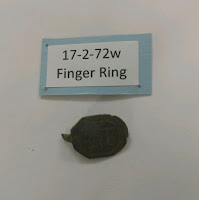Hello everyone, it's Joey again. Even as the end of a field school draws
near, great and exciting finds are often revealed. In fact, one of the greatest
finds this year was recovered on the Tuesday before we were supposed to pack up,
our second to last day to work in our units. On that day, in the unit North 23
East 9, Diana and I began to uncover strange soil patterns in the south half of
our unit as we were trying to level it out at 50 cmbd. We were soon told to
excavate around it, and for good reason, as we found that it was lining up
nearly perpendicular with another soil formation in the north half and both
went nearly as straight as an arrow. Surrounding this strange and unnatural
soil formation, we also found large pieces of charcoal and pockets of ash,
yet strangely no signs of oxidized (burnt) soil, and the opposite had been encountered
in a previous unit to the west.
This indeed piqued the interest of
our supervisors, who soon declared that we had found feature 28, the corner of a
three-hundred-year old French house! Finally, after a month and a half of
excavations we had found the architectural remains we were hoping to. We could scarcely contain our excitement. Wasting
little time, we soon began taking samples from various areas of the unit,
including carbon 14 samples of the two great charcoal chunks in hopes of dating
them with fairly accurate precision and to determine what species of
trees they came from. After accomplishing that, we attempted to take a float
sample from the area that had the greatest concentration of charcoal to try to
find other organic remains but were unable to accomplish this as we were pressed for time. To our joy, we found two possible post holes only a half
centimeter from this concentration and thus further excavation there was
stopped in an attempt to preserve them for further study in future years.
 |
| This photograph depicts the feature very well. |
Another interesting part of our
feature was that it lined up in a nearly perfect line with a line of B horizon fill (the B horizon soil is usually found below the soil present during the fort’s
occupation) in North 20 East 3 that was also being excavated this year. We
believed that this showed that there was once a ditch that had been dug here in
the 1700’s. The line between feature 28 and this possible ditch only serves to
further reinforce this theory.
Finally, on our very last day of
excavations we uncovered a chain of either a necklace or bracelet inside our feature that
was still clasped. This was indeed a rare find as no other intact jewelry chain has been recovered at the Fort so far. Now as we wrap up lab work back at
WMU, I deeply hope that further work and study is put into this feature in later
years.









